The Ultimate Guide to Workplace Wellness Challenges for HR Leaders
Last Updated Sep 17, 2025

Your team’s feeling drained. Stress levels are high, energy is low, and focus? Scattered.
Burnout doesn’t always show up as dramatic breakdowns. Sometimes it looks like that 2 p.m. fog, skipped lunches, or another “I’ll exercise tomorrow” excuse. And when that becomes the norm, performance dips, morale plummets, and retention gets shaky.
That’s why workplace wellness challenges are more than just feel-good perks. They’re strategic tools that build healthier habits, stronger teams, and sharper minds — all while boosting your bottom line.
Want to energize your workforce, elevate company culture, and cut healthcare costs along the way? Discover how wellness challenges can transform your organization from the inside out.

What You’ll Learn
- Wellness challenges improve employee health and focus, leading to higher energy, reduced stress, and stronger work-life balance—key contributors to better job performance and satisfaction.
- They boost morale, engagement, and productivity, with employees feeling more valued and energized. Organizations report up to 84% productivity gains when wellness is prioritized.
- Cost savings are real. Companies experience reduced absenteeism and lower healthcare costs—72% saw medical savings from wellness programs.
- They enhance company culture and employer branding, helping attract and retain top talent. A positive wellness culture fosters camaraderie, loyalty, and a more inclusive workplace.
- Effective challenge design is critical: Tailoring activities to employee interests, offering easy tracking, including leadership participation, and adding rewards all increase participation and impact.
Dive deep into how workplace wellness can make your organization more successful.
Why Workplace Wellness Challenges Matter: Benefits for Employees and Employers
Workplace wellness challenges deliver tangible benefits to both employees and the organization. Here’s how these challenges boost wellbeing and business results:
For Employees:
- Improved Physical & Mental Health: Regular wellness activities help employees get healthier and happier. Physical challenges (like step contests or exercise breaks) improve fitness and energy levels, while mental health challenges (like mindfulness or gratitude journaling) reduce stress. Healthier employees report higher job performance and focus – for example, employees with healthy eating habits are 25% more likely to have better job performance.
- Increased Energy and Focus: Wellness challenges encourage habits that fight that mid-afternoon slump. Whether it’s a daily 30-minute walk or a hydration challenge, employees build routines that boost their energy and alertness. Over time, participants often feel more “awake” and attentive at work, leading to sharper focus on tasks.
- Stress Reduction: Guided meditation sessions, digital detox days, or even fun team challenges can significantly cut stress. When employees have outlets to manage stress (like mindfulness or exercise challenges), they feel more balanced. This matters because work stress is rampant – 47% of employees say work stress degrades their mental wellbeing. Wellness challenges provide healthy coping mechanisms to keep stress in check.
- Team Building & Camaraderie: Tackling wellness goals together builds camaraderie. Employees cheer each other on in step challenges or swap healthy recipes in a nutrition challenge. This friendly competition and support break down silos. People form new connections across departments – suddenly accounting and sales are bonding over who drank more water this week! The result is a tighter-knit team and a more inclusive culture.
- Enhanced Work-Life Wellness: Wellness challenges send a clear message that taking care of yourself is part of the job. By encouraging habits like getting enough sleep, unplugging after hours, or exercising, challenges help employees better integrate work and personal life. This leads to less burnout and a greater sense of balance. In one survey, 41% of people said they enjoy their job because of good work-life balance – challenges can help create that balance.
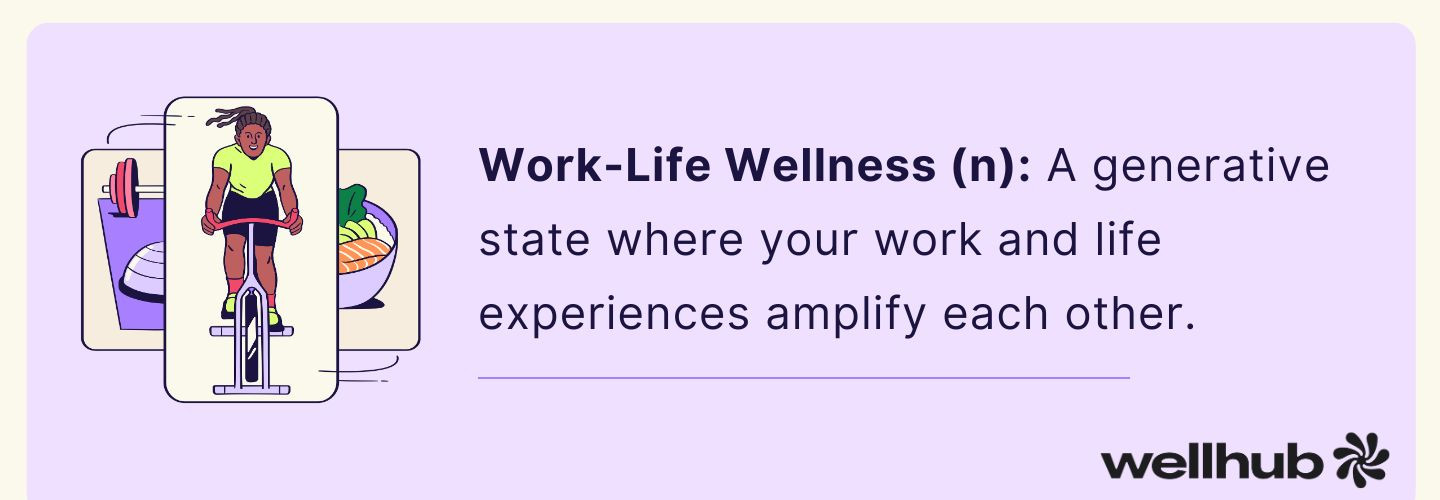
For Employers:
- Higher Employee Engagement & Morale: Wellness challenges make employees feel valued, which boosts morale and engagement. When people see their company investing in their wellbeing, they’re more likely to be motivated and engaged – 93% of workers who feel valued are driven to do their best work. Challenges inject fun into work and give employees something to look forward to, lifting overall spirits.
- Reduced Absenteeism & Presenteeism: Healthier, less-stressed employees take fewer sick days and are more fully present when at work. For example, in a U.S. pilot program within a major health organization, 85% of employees who received stress-focused group therapy returned to work and had no additional absences in the next 11 months. The average number of days off work for mental health purposes decreased after participation (from an average of 12 days before intervention to 8 days after). By encouraging preventive health habits (exercise, nutrition, etc.), wellness challenges can cut down on unplanned absences and on-the-job burnout. Fewer days lost to illness or disengagement means a more productive workforce.
- Improved Productivity: Energized employees get more done. Wellness challenges often translate into tangible productivity gains – in 2024, 97% of CEOs said their wellness programs boosted their productivity, and nearly half (47%) said it had a major impact on their workforce productivity. Whether it’s the mental clarity from meditation or the stamina from daily exercise, employees who participate in wellness activities tend to be more focused and efficient on the job.
- Lower Healthcare Costs (Long-Term): While wellness challenges aren’t a magic wand, over time they can help reduce healthcare spend by improving employees’ health metrics. Healthier lifestyles lead to fewer chronic illnesses and claims. In fact, 72% of companies saw reduced healthcare costs after implementing wellness programs. CEOs agree too – 68% say their wellness program helps cut healthcare costs. Those savings can be significant in the long run, improving your organization’s bottom line.
- Enhanced Company Culture & Employer Brand: A company that cares about wellbeing builds a positive reputation. Wellness challenges create a culture of support, fun, and personal growth. This not only makes current employees happier, but also strengthens your employer brand: 76% of CEOs say their wellness initiatives significantly impact brand perception. Companies known for wellness and work-life balance attract talent who value those perks. It’s a virtuous cycle: a healthy culture becomes a magnet for top candidates (indeed, nearlynine out of 10 job seekers will only consider a company that places a clear emphasis on wellbeing).
- Better Talent Attraction & Retention: Wellness initiatives can be a secret weapon in retaining your people. When employees feel healthy and supported, they’re less likely to leave for a competitor. Sixty-six percent of CEOs feel strongly that employees would consider leaving if their company didn’t prioritize wellbeing – that’s two-thirds of leaders recognizing wellness as key to retention. In tight labor markets, offering wellness challenges can set you apart as an employer that “gets it,” keeping your team intact and attracting new talent who seek a healthy workplace.
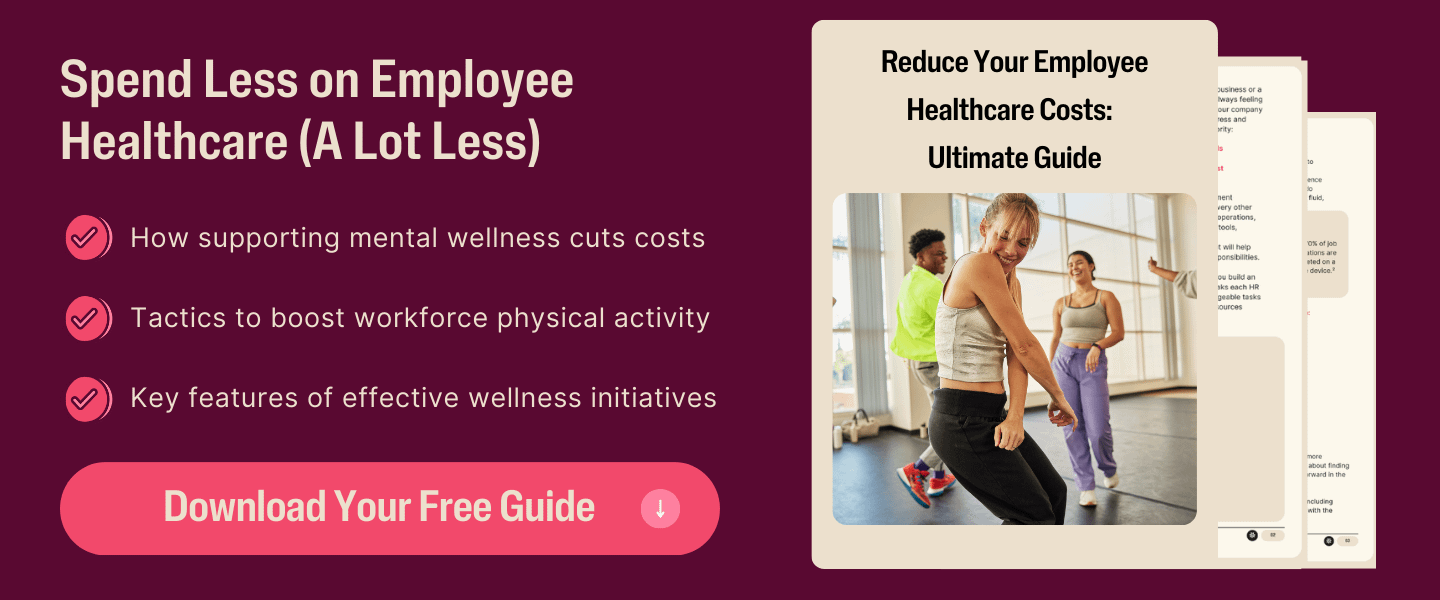
Statistics Showing How Wellness Challenges Strengthen U.S. Companies
Recent studies show clear ROI and positive impacts of wellness programs and challenges in the workplace. Here are some powerful stats that HR leaders should know, and share with their C-suite to gain top-down support:
- Return on Investment: Corporate wellness pays off, literally. One study by Avalere Health, funded by the U.S. The Chamber of Commerce, shows that every $1 spent on employee wellness, companies see about a 47% return on investment on average. Put another way, a well-run wellness program can return roughly $1.47 in benefits (through reduced medical costs, higher productivity, etc.) for each $1 invested. That’s a compelling business case for wellness initiatives.
- Productivity Gains: Healthy employees are productive employees. In 2023,84% of employers reported higher employee productivity and performance thanks to their wellness plans. Additionally, when wellness programs address both physical and mental health, half of companies see productivity jump in their workforce. If your staff could get more done and feel better doing it, why not encourage that through a fun challenge?
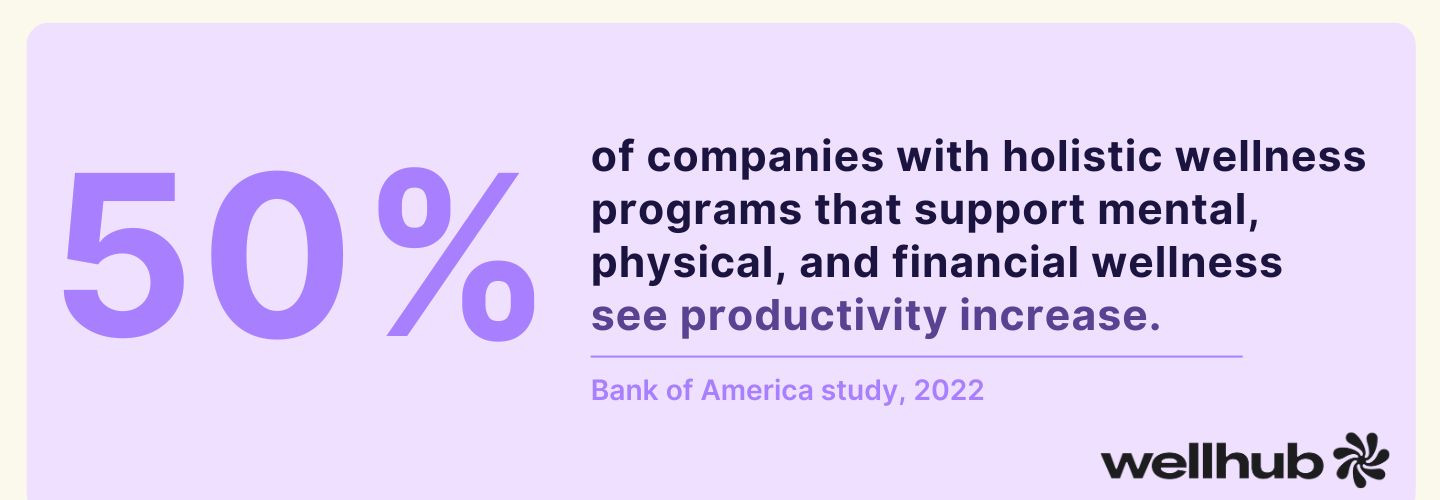
- Healthcare Cost Reduction: Rising healthcare costs are a huge concern for HR and finance alike. The good news: wellness efforts can bend that cost curve. About 72% of companies observed a reduction in healthcare expenses after introducing wellness programs. Even CEOs are noticing this trend – over two-thirds (68%) of CEOs say their wellness programs contribute to lower healthcare costs. Preventive care challenges (like fitness or screening drives) can save money by catching issues early or avoiding them altogether.
- Retention & Morale: Wellness challenges help you keep your talent. As revealed in Wellhub’s Return on Wellbeing 2025 study, 66% of CEOs agreed that employees might leave if wellness isn’t prioritized. Conversely, 73% of CEOs say their wellness program has improved employee retention at their company. High turnover is expensive – investing in employee wellbeing can significantly boost loyalty. It also uplifts morale: 52% of CEOs invest in wellness specifically to boost employee morale and engagement, recognizing that happy employees stick around.
- Employer Branding & Talent Attraction: A commitment to wellbeing makes your company more attractive. Seventy-six percent of CEOs report that their wellness initiatives have a significant positive impact on brand perception. And 80% of CEOs say wellness programs strengthen their ability to attract talent – nearly half call it “extremely impactful” for recruiting. In competitive hiring markets, offering innovative wellness challenges (and promoting your results) can differentiate your organization as one that truly values employees.
As you can see, workplace wellness challenges pack a serious punch. They drive outcomes that every HR leader cares about – engagement, productivity, cost savings, retention, and culture. Next, we’ll explore how to design challenges that maximize these benefits for your team.
Here’s how to find a whole-person wellness program that boosts performance.
20 Actionable Workplace Wellness Challenge Ideas
Ready to get creative? Below are 20 wellness challenge ideas across four categories – physical health, mental/emotional wellbeing, nutrition, and holistic lifestyle. Each idea includes a brief description and an actionable tip to help you implement it. Mix and match these challenges to suit your workforce. The key is to keep them fun, inclusive, and aligned with your goals!
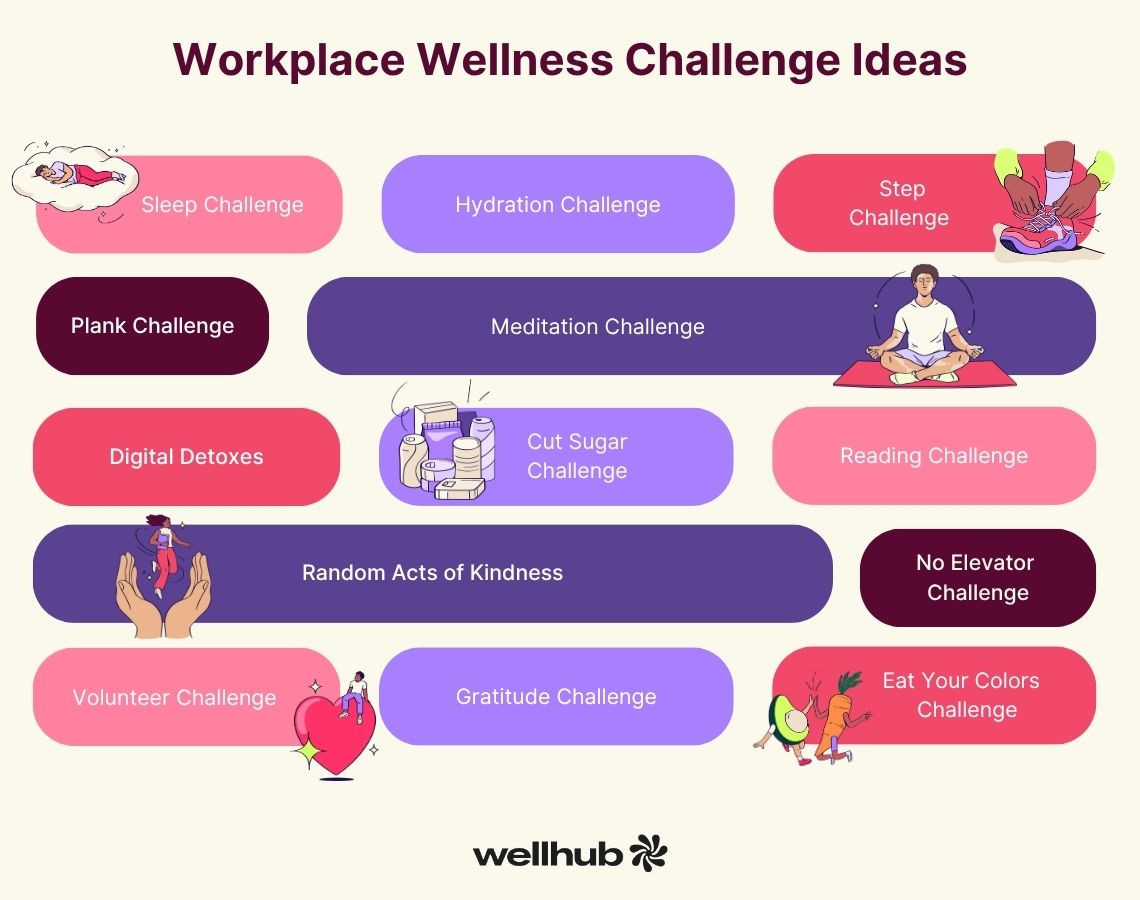
Physical Health & Fitness Challenges
These challenges get employees moving and are classics for a reason – they’re simple and effective.
Step Challenge: Turn walking into a team adventure. Set a collective step goal like “Race to the Moon” (238,900 miles as a team!) or a virtual cross-country trek. Employees use pedometers or smartphone apps to track steps daily. This challenge is easy for all fitness levels – whether you take lunchtime walks or just park farther away, every step counts.
Actionable Tip: Provide inexpensive pedometers or share a list of free step-tracking apps to make participation easy. Consider displaying a leaderboard or a map tracking your team’s progress toward the big goal to keep motivation high.
“Daily 30” Exercise Challenge: Encourage everyone to be active for 30 minutes a day, doing any physical activity they enjoy. One person might jog, another might do yoga, someone else might dance with their kids – it all counts! The idea is to build a routine of daily exercise.
Actionable Tip: Offer options to accommodate different schedules and preferences. For example, organize a few group activities like a virtual 30-minute workout class at lunchtime or a group walk after meetings. Employees can also buddy up for accountability. The variety ensures each person can find an activity that suits them while still sharing in the group goal.
Hydration Challenge: Proper hydration is key to health and focus, but we all forget to drink water during busy days. In this challenge, employees aim to drink a set amount of water (for example, 8 glasses, or ~2 liters) each day. You can make it fun by “gamifying” water intake – e.g., each person fills a chart or uses an app and gets a point for each glass.
Actionable Tip: Hand out branded reusable water bottles at the start of the challenge to everyone (hydrate in style!). You could also place water coolers or flavored water dispensers in the office as a friendly nudge. If people are remote, encourage sharing creative infused-water recipes or do a mid-day “water break” reminder on Slack.
Plank or Core Strength Challenge: A strong core improves posture and reduces back pain for those desk-bound jobs. This challenge invites employees to do a plank (holding a push-up position) or other core exercise every day, starting with, say, 20 seconds and increasing incrementally. By the end of a month, folks will be surprised by how long they can hold a plank!
Actionable Tip: Share a short instructional video on proper plank form (to avoid injuries). You can make it social by having a 2-minute core session each day at a set time – for example, “3 PM Plank Break” where everyone stops to plank or do desk-friendly ab exercises together (virtually or in-person). It’s quick, mildly challenging, and often results in laughter and team bonding as everyone trembles through the last 10 seconds together!
“No Elevator” Challenge (Stair Climb Challenge): If your building has stairs, turn them into a fitness tool. For a day or a week, encourage employees to skip the elevator and take the stairs whenever possible. Track how many flights everyone climbs cumulatively – you could even frame it as “Climb the Eiffel Tower” (which is ~1,700 steps) or other famous tall structures.
Actionable Tip: Place cheerful signs near the elevators and stairwell doors as reminders (e.g., “Challenge in progress – take the stairs for your health!”). You can have participants log flights climbed in a shared sheet or app. Recognize everyone who participates, and maybe give a small prize to the person or team who climbs the most flights in the week. (Safety note: This works best for a reasonable number of floors – don’t make someone hike 50 flights; you can encourage walking up a few and then taking the elevator if needed.)
“Deskercise” / Movement Breaks: Long hours at the desk can wreak havoc on the body. This challenge introduces short movement breaks throughout the day. For example, “5-minute stretch every hour” or a couple of scheduled group stretch breaks. You could compile a list of simple desk stretches or exercises (neck rolls, chair squats, shoulder stretches, etc.) and encourage folks to tick them off a list each day.
Actionable Tip: Lead by example – have a different department head or volunteer lead a 5-minute stretch or exercise break at a set time (like 11am and 3pm daily). They can play a peppy song and everyone does a quick routine together. If live group breaks aren’t feasible, share a short video/gif of a stretch and challenge everyone to do it at a certain time, then maybe post a fun emoji in chat when done. Regular movement breaks will get blood flowing and reduce the stiffness and fatigue of desk work.
Get employees moving:
- 30 workplace wellness activities
- 17 plug-and-play physical wellness ideas
- 5 actionable employee fitness challenge ideas.
Mental & Emotional Wellbeing Challenges
With stress and burnout on the rise, these challenges focus on mental health, mindfulness, and fostering a positive mindset.
Mindfulness & Meditation Challenge: Help employees find a moment of zen each day. This challenge might be “meditate for 10 minutes daily” or simply practice any mindfulness activity regularly (deep breathing, mindful walking, etc.). Even a short daily meditation can reduce stress and improve focus.
Actionable Tip: Provide resources to get started – for example, share links to free meditation apps or YouTube guided meditation videos. You could kick it off with a live guided meditation session (perhaps bringing in a local instructor virtually). Create a quiet space in the office for those who want to meditate on breaks, or encourage folks to block 10 minutes on their calendar as “Meditation Time.” The goal is to normalize taking a mental pause. Consider a group check-in: “How do you feel after a week of daily meditation?” to let people share benefits or challenges.
Gratitude Challenge: Cultivating gratitude can boost mood and resilience. In a gratitude challenge, employees take a few minutes each day to jot down things they’re grateful for. For example, each person might keep a gratitude journal of 3 things they’re thankful for every day, or you create a shared “gratitude wall.”
Actionable Tip: Create a physical bulletin board or a virtual channel where team members can voluntarily post one thing they’re grateful for each week (work-related or personal). It’s uplifting to read others’ entries (“I’m grateful for my supportive team during our busy season” or “Grateful for the sunshine on my walk this morning”). As HR, you can prompt reflection by providing a simple journal or fun template for daily gratitude notes. At the end, consider compiling anonymous highlights of what people appreciated – it spreads positive vibes and reinforces a culture of appreciation.
- Digital Detox Challenge: After work hours (or during lunch breaks), encourage employees to unplug from screens. This challenge could be framed as “No-screen evenings” a few times a week or a “30-Minute Tech-Free Lunch” every day. The aim is to reduce burnout and digital overload by setting healthy tech boundaries.
- Actionable Tip: Define the parameters clearly – for instance, challenge everyone to avoid checking email or work apps after 7 PM for two weeks, or establish “Tech-Free Tuesday after 8 PM” where folks do hobbies or family time instead of screen time. During the workday, you might suggest a “phone-free lunch” where people step away from their computers and phones entirely to recharge. Encourage participants to share what they did instead (read a book, took a walk, had an actual conversation!). By the end, employees often report feeling more refreshed. Remind managers to respect these boundaries too – e.g., avoid sending non-urgent messages at night – as that reinforces the detox habit.
Stress Relief Challenge: Help your team discover and practice effective stress-busting activities. This challenge invites employees to try different stress reduction techniques and find what works for them. For example, each day they might do one thing that helps them relax or recharge: Monday meditate, Tuesday take a nature walk, Wednesday do a 10-minute yoga stretch, Thursday listen to calming music, Friday practice a hobby, etc.
Actionable Tip: Offer a menu of stress-relief activities employees can choose from and encourage them to pick at least one each day. You can share resources like “Quick breathing exercise guide,” “5 stretches to release tension,” or a funny cat video – whatever lightens the mood. A fun twist is to create a “stress bingo” or checklist (e.g., 20 different stress relief ideas, from taking a hot tea break to decluttering your desk) and see who can complete the most in a month. Also, remind folks of any Employee Assistance Program (EAP) resources or counseling services available – the challenge can raise awareness that it’s okay to seek support. The ultimate goal is employees learning new habits to manage stress even beyond the challenge.
“Random Acts of Kindness” Challenge: Foster positivity and social wellness by encouraging employees to perform small acts of kindness for colleagues (or even family and community). This could range from giving a genuine compliment, writing a thank-you note, helping a teammate with a task, or bringing in healthy snacks to share. Each day or week, participants strive to do at least one kind act.
Actionable Tip: Create a shared “kindness tracker” or kudos board. People can (anonymously, if they wish) jot down the kind acts they did or witnessed others doing: “Someone left a nice note on my desk – made my day!” This not only motivates more kindness but also spreads good news in the workplace. You might provide some blank thank-you cards in common areas for easy note-writing. At the end of the challenge, celebrate the collective impact – e.g., “Together, we completed 150 acts of kindness this month!” Perhaps cap it off with a small celebration or group volunteer afternoon, reinforcing that kindness is part of your culture.
Strengthen workplace mental health:
- 7 proven strategies to strengthen emotional wellness at work
- Build psychological safety with these data-backed strategies
Nutrition & Healthy Eating Challenges
Food fuels performance. These challenges help employees make healthier eating choices in an enjoyable way.
“Eat Your Colors” Challenge: This is a fun way to increase fruit and veggie intake by focusing on colorful foods. Challenge participants to eat a serving of produce from each color of the rainbow over the course of a week (e.g., berries for red, carrots for orange, spinach for green, blueberries for blue/purple, bananas for yellow, etc.). It can be a game to see how many colors they check off daily.
Actionable Tip: Share simple healthy recipes featuring fruits and vegetables. For example, send out a weekly recipe email (“Try this easy stir-fry packed with red, green, and yellow veggies”). You could even turn it into a photo sharing event: employees post a pic of their colorful meal in a Slack channel or on a breakroom board. Consider providing a small incentive like a farmers market voucher for those who complete a full rainbow in a week. This challenge is inclusive because it’s about adding good stuff (not shaming any other food choices) – and it often sparks conversations (“I never knew I liked yellow bell peppers until this!”).
Healthy Breakfast (or Lunch) Challenge: Encourage employees to swap the donuts or fast food for healthier home-prepared meals. For a set period (say two weeks), participants commit to eating a nutritious breakfast or packing a healthy lunch from home each workday. They can plan meals that emphasize whole foods – whole grains, lean protein, fruits/veggies.
Actionable Tip: Make it interactive by organizing a “healthy recipe swap.” Employees can submit their favorite simple healthy meal recipes, and you compile them into a little digital cookbook to share. You might also host a healthy potluck or tasting event at the end of the challenge where everyone brings a wholesome dish to share (if in person). If many are remote, consider a virtual lunch where people show their healthy meal and share what’s in it. Offer resources on quick meal-prep strategies for busy professionals (overnight oats, salad jars, etc.). Recognize those who complete the challenge with a fun title like “Wellhub Wellness Chef” and share the most popular recipes company-wide.
Sugar Reduction Challenge (“Sugar Swap”): Most of us consume more sugar than we realize, which can affect energy and health. In this challenge, employees aim to cut down on added sugars. It could be structured as “no soda for a month” or “replace your usual dessert with a piece of fruit daily” or generally trying to stay under a certain sugar gram threshold.
Actionable Tip: Focus on substitution rather than just elimination – provide healthy snack alternatives in the office, such as nuts, fruit, or yogurt instead of candy and cookies. If your office has a vending machine or pantry, stock it with some low-sugar options and highlight those. Educate participants with a short weekly email: for example, spotlight hidden sugars in common foods or share a recipe for energy bites using dates instead of cookies. Employees can share their experiences (“Switched my sugary latte for herbal tea – feeling good!”). Even a small cutback can make a difference in energy levels. You might measure success collectively (e.g., “as a team we avoided X teaspoons of sugar”) to show impact. And don’t forget to celebrate – perhaps with a naturally sweet fruit salad party instead of cake!

Holistic & Lifestyle Challenges
These challenges go beyond the usual diet-and-exercise, touching on financial health, personal development, and community – acknowledging that wellbeing is multi-dimensional.
Sleep Challenge: Quality sleep is crucial for productivity and health, yet many professionals burn the midnight oil. This challenge encourages employees to prioritize sleep – for example, aiming for 7 to 8 hours of sleep each night for two weeks. Participants can track their sleep duration (some might use apps or fitness trackers, or just self-report).
Actionable Tip: Share science-backed tips for better sleep hygiene, like maintaining a consistent bedtime, creating a bedtime routine, or limiting screens before bed. You could even distribute a small sleep wellness kit (earplugs, lavender sachet, or an eye mask) to kick it off. Have a discussion or Slack thread where people share what helped them (a dark room, chamomile tea, reading a book instead of phone at night, etc.). Emphasize it’s not a competition of who can sleep the most, but about establishing healthy patterns. After the challenge, ask if they feel a difference – many will report improved mood and focus. That drives home the point: well-rested employees perform better.
Financial Wellness Challenge: Financial stress can weigh heavily on employees’ minds (and 61% say it’s a top source of anxiety). Help staff build financial fitness with a challenge around budgeting, saving, or financial learning. For example, a 4-week financial wellness challenge might include weekly tasks: Week 1 create a simple budget, Week 2 save an extra $X (like skip a takeout and put $20 in savings), Week 3 learn something new (attend a mini financial webinar or read an article), Week 4 tackle a financial to-do (like reviewing your 401k or debt payments).
Actionable Tip: Partner with your finance team or an external financial advisor to host a short webinar or Q&A for employees – e.g., “Budgeting 101” or “Planning for Retirement.” Provide a basic budgeting template or app recommendation. Encourage employees to set a personal savings goal for the month (even small wins count). This challenge is more private; you won’t ask people to publicly share dollar amounts, but you can discuss general tips or resources. By improving financial literacy and habits, employees gain peace of mind – and an employee not distracted by money worries can be more present at work.
Reading (Personal Growth) Challenge: Stimulate minds and encourage continuous learning with a reading challenge. It could be as simple as “read for 15 minutes a day” (any book, article, not work-related) or more structured like a company book club where everyone reads the same book over a month. Alternatively, set a collective goal like “Team reads 100 books this year” with participants logging any books they finish.
Actionable Tip: Launch a virtual book club or a "reading" Slack channel for interested folks to share what they’re reading. You might suggest a mix of personal development books (to build skills) and fun fiction (to relax – both have value!). If doing a shared book, host a casual discussion session (with coffee/tea) at the end of the challenge to chat about key takeaways and how they might apply to work or life. Recognize participants by listing all the books read by the team – it’s rewarding to see that list grow. This challenge promotes intellectual wellness and gives people a break from screens. Plus, employees might discover common interests (“You read that too? Let’s discuss!”) – building social connections.
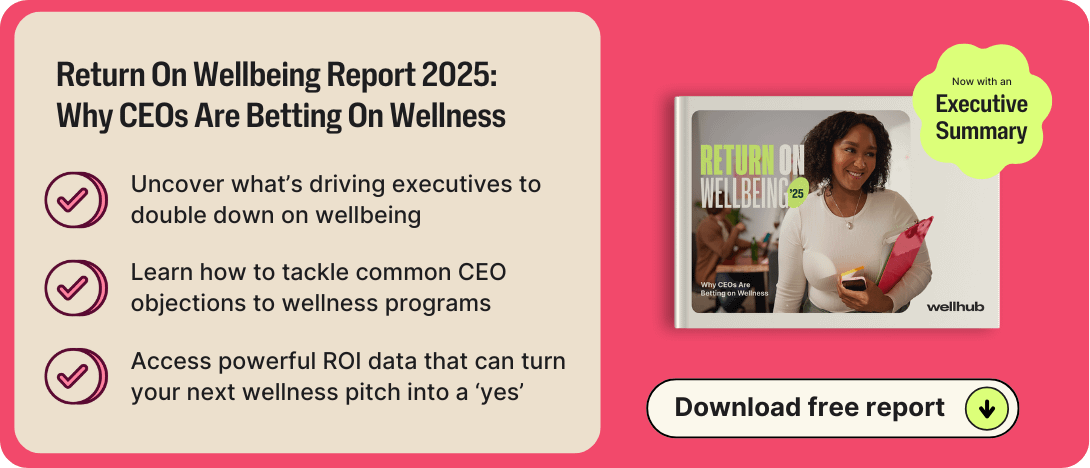
Sustainability/Eco-Challenge: Link wellness to doing good for the planet. An eco-challenge can improve environmental wellness (a sense of responsibility and purpose) and often involves physical activity or team bonding too. Examples include a commute green challenge (carpool, bike, or use public transit a certain number of days), an office recycling or waste reduction challenge (try to produce zero landfill waste for a day), or energy-saving challenge (everyone turns off electronics after work, etc.).
Actionable Tip: Pick a few eco-actions and create a bingo or checklist (e.g., “Bring a reusable mug,” “Bike to work,” “Volunteer for a community clean-up,” “Use both sides of the paper”). Employees earn points or bingo for each action they do in a month. Encourage sharing photos – like someone biking to work or a team doing a park trash pickup (great for social media shout-outs too, highlighting your company values). Small competitions between teams (which team logs the most eco-actions) can spur engagement. This kind of challenge boosts wellbeing by instilling pride and camaraderie in making a difference. It’s a win-win: employees feel good, and the company reduces its carbon footprint bit by bit.
Community Service/Volunteering Challenge: Altruism and community connection are key aspects of wellbeing. This challenge motivates employees to give back, which can be incredibly fulfilling and great for team building. For instance, set a collective goal of X volunteer hours in a quarter, or organize a company-wide volunteer day (or series of events) and challenge each department to get involved.
Actionable Tip: Partner with local charities or use a platform to find volunteer opportunities (Habitat for Humanity build, charity walk, local food bank, etc.). Offer a few options (including virtual or skills-based volunteering for remote folks). You could track participation by hours or projects completed. Some companies give a day off for volunteering – if you can, introduce a “Volunteer Friday” where teams go out and help in the community. Make it celebratory: take pictures (with permission) and share stories of impact in an internal newsletter or town hall. For example, “Our team cleaned up 5 miles of beach” or “We packed 200 meal kits for families in need.” The challenge can end with a showcase of all the good done by employees. This not only improves employee wellbeing (kindness and connection boost mood) but also strengthens your company’s ties to the community.
Each of these challenge ideas can be adapted to fit your company’s size, budget, and whether your workforce is on-site, remote, or hybrid. Feel free to start with just a few ideas and expand over time. The key is to listen to your employees, keep the spirit upbeat, and celebrate progress. By offering a variety of challenges, you’ll engage more people – someone who isn’t into running might love the reading challenge; a shy person might skip group yoga but really enjoy the gratitude journal. Over the year, a well-rounded wellness challenge program touches on multiple dimensions of wellbeing, so everyone finds something that resonates.
Keep top talent inspired with this professional growth blueprint. [20 ideas]
14 Workplace Wellness Challenge Tips for Designing Impactful Initiatives
So you’ve found a few wellness challenges you love – great! Now, how do you actually create challenges that work for your organization?
A wellness challenge program can fall flat if it’s not tailored and executed well. Here are key considerations for HR leaders when designing impactful workplace wellness challenges:
- Setting Clear Goals: Start with the why. What do you want to achieve with a wellness challenge? Identify the primary goal(s) – for example, “increase physical activity among employees,” “reduce stress levels,” or “promote team bonding.” Clear goals will guide the type of challenge you choose and how you measure success. Tie goals to company priorities too: if reducing healthcare claims is a priority, maybe a fitness or preventive care challenge makes sense. If improving morale is key, a fun team-based challenge might be the ticket. Define what success looks like (e.g., 60% of employees participate, or average steps increase by 20%). With targets in mind, you can design challenges with purpose and rally leadership support by showing how the challenge aligns with business outcomes.
- Understanding Your Workforce: One size does not fit all in wellness. The best challenges are the ones that resonate with your employees’ interests and needs. Before launching anything, get input from your people. You can send a quick survey or hold a focus group to ask: “What wellness activities would you enjoy or benefit from?” You might discover your staff is more interested in mindfulness and financial wellness than marathon running – or vice versa. Consider factors like age range, job type (desk workers vs. field workers), and existing pain points. If many employees are glued to their desks, a stretching or step challenge could be popular. If work stress is high, a meditation or “unplug after 6pm” challenge might hit the spot. By tailoring challenges to your workforce, you show you’re listening and you’ll get much higher participation. (Tip: Allow employees to suggest challenge ideas, or even form a wellness committee – this boosts buy-in from the start.)
- Leverage an All-in-One Platform: Simplify setup, participation, and tracking by using an integrated wellness platform like Wellhub. With its Challenges feature, HR teams can easily launch step-based or check-in–based challenges, invite employees with a link or QR code, and track participation in real time—all in one place. Built-in gamification, automated tracking via fitness app integrations, and customizable team or individual formats boost engagement while reducing admin lift. Plus, employees without a paid plan can still join, making it inclusive and scalable across your workforce.
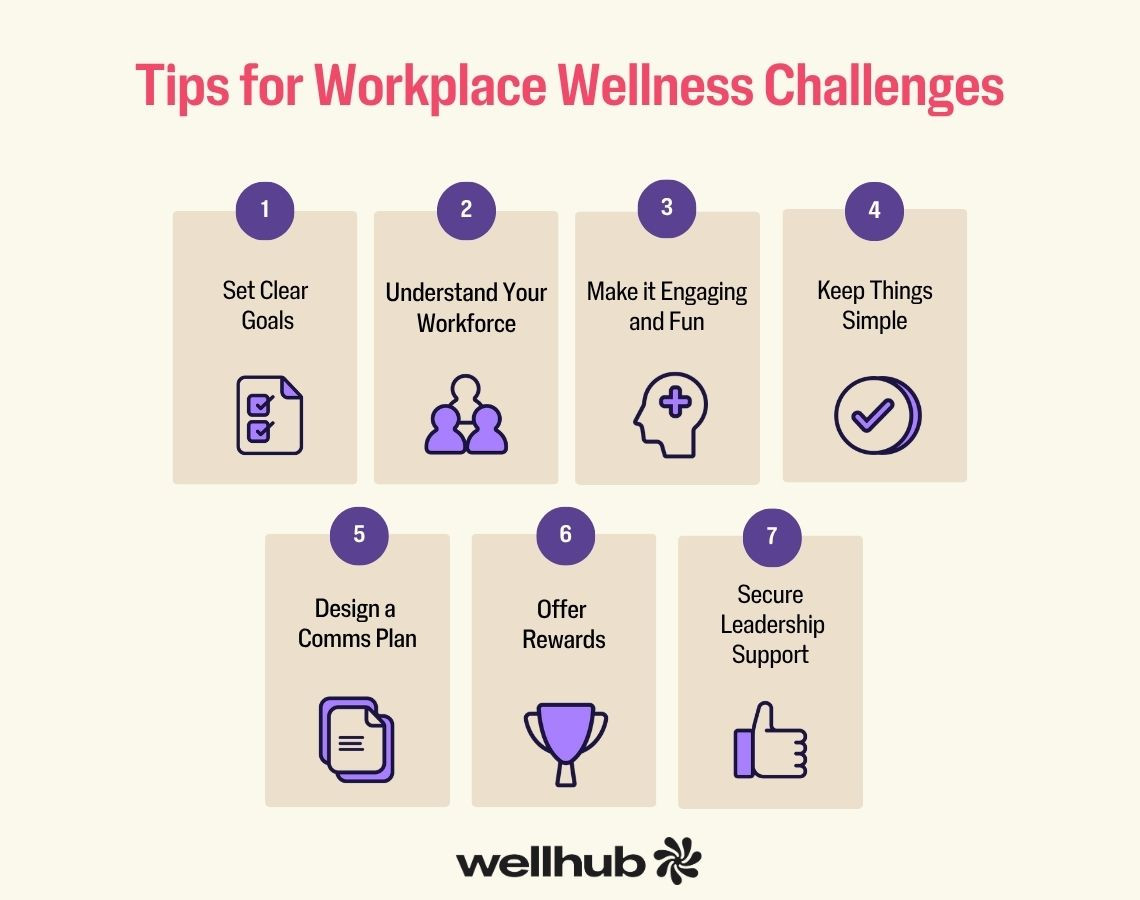
- Making it Engaging & Fun: The quickest way to kill a wellness challenge is to make it feel like a chore. Keep it fun! Introduce elements of play and teamwork to spark enthusiasm:
- Gamification: Humans are naturally competitive (at least a little). Tap into that by using points, badges, or leaderboards. For example, employees earn points for each healthy activity they complete (10 points for a workout, 5 points for a healthy meal, etc.), and you maintain a friendly leaderboard. Small gamification touches – like virtual badges for completing weekly goals – can motivate people to stick with it.
- Team-Based vs. Individual: Consider running challenges in teams or pairs, not just individual competition. Team challenges (e.g., department vs. department step counts) build camaraderie and let people encourage each other. They’re great for offices with strong team spirit. Individual challenges, on the other hand, allow personal accountability and flexibility (good for diverse or remote teams). You can even do both: have individual goals that contribute to a team total, so no one feels alone.
- Variety and Novelty: Keep things fresh. Doing the same walking challenge every month will get stale. Instead, mix up challenge themes – perhaps a fitness challenge this quarter, a mental wellness challenge next, and a nutrition challenge after that. Within a challenge, introduce mini-goals or weekly themes (for example, a step challenge could have a week focused on “take the stairs,” another on “walking meetings,” etc.). Novelty prevents “challenge fatigue” and engages different people’s interests over time.
- Inclusive for All Levels: Ensure your challenges are accessible to everyone, not just the ultra-fit or extroverted. Design activities that can be scaled to different abilities. For instance, a physical activity challenge could count any exercise (yoga, walking, cycling) so people of varying fitness levels can participate. Provide alternatives or modifications – if someone can’t do high-impact workouts, they can stretch or do chair exercises and still earn points. Inclusivity is crucial; no one should feel excluded or embarrassed. The goal is to lift everyone up, no matter where they’re starting from.
- Gamification: Humans are naturally competitive (at least a little). Tap into that by using points, badges, or leaderboards. For example, employees earn points for each healthy activity they complete (10 points for a workout, 5 points for a healthy meal, etc.), and you maintain a friendly leaderboard. Small gamification touches – like virtual badges for completing weekly goals – can motivate people to stick with it.
- Streamline Participation & Tracking: Remove barriers to join and track progress, or people will drop off. Keep challenge rules simple and clear – a one-page guideline or kickoff meeting should be enough for everyone to understand how to participate. Leverage technology to make tracking easy: there are many wellness apps and platforms (some companies use their existing wellness program app, or even a simple Google Sheet or Slack channel) where employees can log their activities. For example, if you run a step challenge, employees could use their smartphone’s step counter or a free app to record steps, and then sync or input their totals. In smaller organizations, an honor system or manual tracking chart on the breakroom wall can work too – what matters is that it’s not cumbersome. Make sure everyone knows how to report their progress and can see updates. Regularly sharing progress (“Collectively, we’ve walked 500 miles this week – amazing!”) keeps momentum going.
We made it easy: Launch your wellness program with this step-by-step guide.
- Communication Strategy: “If you build it, they will come” doesn’t apply if nobody knows about the challenge! A strong communication plan will generate interest and sustain it. Start with an exciting launch announcement – for example, an email or all-hands meeting where leadership introduces the challenge and its benefits. Use multiple channels: office posters, team Slack messages, a blurb in your HR newsletter, etc., to catch everyone. Outline the challenge timeline, how to join, and what’s in it for them. During the challenge, keep the buzz going: send weekly updates or fun reminders (“Mid-week hydration check – is your water bottle feeling lonely?”). Highlight success stories or shout-outs (“Kudos to Alex for completing 5 lunch walks this week!”). Encourage employees to share their own tips or photos (maybe a shared wellness Challenge chat or an intranet page). A steady drumbeat of positive communication will keep people engaged from start to finish.
- Rewards & Recognition: While the ultimate reward is better health, a little incentive never hurts to drive participation. Think about what kind of recognition or prizes you can offer to make the challenge extra motivating. Ideas for incentives:
- Public Recognition: Often, simply recognizing participants is powerful. Give a shout-out to weekly challenge leaders or anyone who achieves a personal goal. You could have a “Wellness Wall of Fame” on the intranet or a mention in the company meeting for top contributors.
- Non-Monetary Rewards: Consider extra vacation hours for the winners, a casual dress-down day, or a “wellness afternoon off” coupon for everyone who completes the challenge. Other popular perks include company swag (t-shirts, water bottles, fitness gear) – a branded water bottle can even support a hydration challenge!
- Monetary/Prize Rewards: If budget allows, small gift cards (think $20-$50 for sports stores, healthy restaurants, or massages) are great incentives. Some companies offer a larger prize for the overall winner or a raffle entry for all who complete the challenge (so even moderate participants have a chance at, say, a fitness tracker or smartwatch).
- Team Rewards: If it’s a team competition, maybe the winning team gets a healthy team lunch or a trophy they can show off. Important: Emphasize that wellness challenges are about personal improvement and team spirit, not cutthroat competition. Recognize all participants for making positive changes, not just the top performer. For example, hold a wrap-up celebration where everyone who participated gets a certificate or a thank-you note from leadership. This keeps the focus on collective wellbeing.
- Public Recognition: Often, simply recognizing participants is powerful. Give a shout-out to weekly challenge leaders or anyone who achieves a personal goal. You could have a “Wellness Wall of Fame” on the intranet or a mention in the company meeting for top contributors.
- Leadership Buy-In and Participation: Culture change starts at the top. It’s critical to have leaders and managers not only support the challenge but ideally join in themselves. When the CEO is logging steps in the challenge or a manager talks about their meditation practice, it shows employees that wellbeing is truly valued (and gives “permission” to prioritize it). Encourage leaders to model healthy behavior – perhaps a senior exec can kick off the healthy eating challenge by sharing a favorite recipe, or a director can post a selfie from a lunchtime walk. Leadership involvement also helps fend off any perception that these activities might be frowned upon. We want employees to know: it’s good to take that wellness break. Tip for HR: get a few enthusiastic leaders on board early, brief them on the goals, and maybe have them do a friendly video or quote: “I’m excited to join our step challenge – who can beat me this month? Game on!” This kind of top-down and peer encouragement boosts participation and makes the challenge part of the company DNA, not just an HR initiative.
With these considerations in mind, you’ll set up wellness challenges for success. Next, let’s explore a variety of wellness challenge ideas – across fitness, mental health, nutrition, and more – and how to bring them to life in your workplace.
57 workplace wellness initiative ideas to transform employee wellbeing.
Wellness Challenges Strengthen Your People and Your Culture
Wellness challenges help employees feel healthier, more focused, and less stressed. They also boost teamwork, morale, and engagement. But without the right structure and support, even great ideas can lose momentum or fall flat. That’s where a strong wellbeing program makes the difference.
The right program makes it easy to launch inclusive, engaging challenges that meet employees’ needs and align with your goals. With the right tools, you can boost participation, support healthier habits, and build a more connected workplace. Companies with successful wellness programs report up to 50% higher productivity and a 23% increase in employee retention.
Speak with a Wellhub Wellbeing Specialist to launch wellness challenges that support your team’s health and help your culture thrive.

Company healthcare costs drop by up to 35% with Wellhub*
See how we can help you reduce your healthcare spending.
Category
Share

The Wellhub Editorial Team empowers HR leaders to support worker wellbeing. Our original research, trend analyses, and helpful how-tos provide the tools they need to improve workforce wellness in today's fast-shifting professional landscape.
Subscribe
Our weekly newsletter is your source of education and inspiration to help you create a corporate wellness program that actually matters.
Subscribe
Our weekly newsletter is your source of education and inspiration to help you create a corporate wellness program that actually matters.
You May Also Like

Corporate Wellness Trends HR Must Know for 2026 | Wellhub
See the top 2026 wellness trends shaping performance, retention, and culture—plus how HR can build a unified, ROI-driven wellbeing strategy.

Wellness Points Programs: Boost Employee Health & Engagement | Wellhub
Turn your workplace wellness strategy around with a points program that rewards healthy behavior with perks, from extra time off to gift cards.

Employee Financial Wellness Programs: Ultimate HR Guide | Wellhub
Create an effective financial wellness program that supports your employees in their financial needs, boosting productivity and retention.